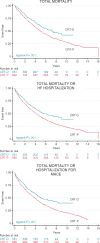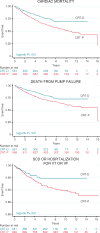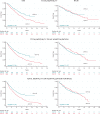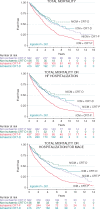Long-term clinical outcomes of cardiac resynchronization therapy with or without defibrillation: impact of the aetiology of cardiomyopathy
- PMID: 29697764
- PMCID: PMC6212789
- DOI: 10.1093/europace/eux357
Long-term clinical outcomes of cardiac resynchronization therapy with or without defibrillation: impact of the aetiology of cardiomyopathy
Abstract
Aims: There is a continuing debate as to whether cardiac resynchronization therapy-defibrillation (CRT-D) is superior to CRT-pacing (CRT-P), particularly in patients with non-ischaemic cardiomyopathy (NICM). We sought to quantify the clinical outcomes after primary prevention of CRT-D and CRT-P and identify whether these differed according to the aetiology of cardiomyopathy.
Methods and results: Analyses were undertaken in the total study population of patients treated with CRT-D (n = 551) or CRT-P (n = 999) and in propensity-matched samples. Device choice was governed by the clinical guidelines in the United Kingdom. In univariable analyses of the total study population, for a maximum follow-up of 16 years (median 4.7 years, interquartile range 2.4-7.1), CRT-D was associated with a lower total mortality [hazard ratio (HR) 0.72] and the composite endpoints of total mortality or heart failure (HF) hospitalization (HR 0.72) and total mortality or hospitalization for major adverse cardiac events (MACE; HR 0.71) (all P < 0.001). After propensity matching (n = 796), CRT-D was associated with a lower total mortality (HR 0.72) and the composite endpoints (all P < 0.01). When further stratified according to aetiology, CRT-D was associated with a lower total mortality (HR 0.62), total mortality or HF hospitalization (HR 0.63), and total mortality or hospitalization for MACE (HR 0.59) (all P < 0.001) in patients with ischaemic cardiomyopathy (ICM). There were no differences in outcomes between CRT-D and CRT-P in patients with NICM.
Conclusion: In this study of real-world clinical practice, CRT-D was superior to CRT-P with respect to total mortality and composite endpoints, independent of known confounders. The benefit of CRT-D was evident in ICM but not in NICM.
Figures




Comment in
-
Cardiac resynchronization therapy in heart failure: is the defibrillator needed?Europace. 2018 Nov 1;20(11):1714-1716. doi: 10.1093/europace/euy152. Europace. 2018. PMID: 29947748 No abstract available.
Similar articles
-
Outcomes of Cardiac Resynchronization Therapy With or Without Defibrillation in Patients With Nonischemic Cardiomyopathy.J Am Coll Cardiol. 2017 Sep 5;70(10):1216-1227. doi: 10.1016/j.jacc.2017.07.712. J Am Coll Cardiol. 2017. PMID: 28859784
-
Adding the implantable cardioverter-defibrillator to cardiac resynchronization therapy is associated with improved long-term survival in ischaemic, but not in non-ischaemic cardiomyopathy.Europace. 2016 Mar;18(3):413-9. doi: 10.1093/europace/euv212. Epub 2015 Sep 15. Europace. 2016. PMID: 26378089
-
Patients upgraded to cardiac resynchronization therapy due to pacing-induced cardiomyopathy are at low risk of life-threatening ventricular arrhythmias: a long-term cause-of-death analysis.Europace. 2018 Jan 1;20(1):89-96. doi: 10.1093/europace/euw321. Europace. 2018. PMID: 28031276
-
Cause-of-death analysis in patients with cardiac resynchronization therapy with or without a defibrillator: a systematic review and proportional meta-analysis.Europace. 2018 Mar 1;20(3):481-491. doi: 10.1093/europace/eux094. Europace. 2018. PMID: 28666319
-
Lessons Learned and Insights Gained in the Design, Analysis, and Outcomes of the COMPANION Trial.JACC Heart Fail. 2016 Jul;4(7):521-535. doi: 10.1016/j.jchf.2016.02.019. Epub 2016 Jun 8. JACC Heart Fail. 2016. PMID: 27289408 Review.
Cited by
-
Topological data analysis to identify cardiac resynchronization therapy patients exhibiting benefit from an implantable cardioverter-defibrillator.Clin Res Cardiol. 2024 Oct;113(10):1430-1442. doi: 10.1007/s00392-023-02281-6. Epub 2023 Aug 25. Clin Res Cardiol. 2024. PMID: 37624394 Free PMC article.
-
Cardiac Resynchronisation Therapy in Patients with Moderate to Severe Heart Failure in Germany: A Cost-Utility Analysis of the Additional Defibrillator.Appl Health Econ Health Policy. 2021 Jan;19(1):57-68. doi: 10.1007/s40258-020-00571-y. Appl Health Econ Health Policy. 2021. PMID: 32215877 Free PMC article.
-
Ventricular arrhythmia events in heart failure patients with cardiac resynchronization therapy with or without a defibrillator for primary prevention.J Arrhythm. 2022 Oct 31;38(6):1056-1062. doi: 10.1002/joa3.12795. eCollection 2022 Dec. J Arrhythm. 2022. PMID: 36524047 Free PMC article.
-
An updated meta-analysis of cardiac resynchronization therapy with or without defibrillation in patients with nonischemic cardiomyopathy.Front Cardiovasc Med. 2023 Jul 12;10:1078570. doi: 10.3389/fcvm.2023.1078570. eCollection 2023. Front Cardiovasc Med. 2023. PMID: 37502189 Free PMC article. Review.
-
Five-year survival and use of hospital services following ICD and CRT implantation: comparing real-world data with RCTs.ESC Heart Fail. 2021 Aug;8(4):2438-2447. doi: 10.1002/ehf2.13357. Epub 2021 May 1. ESC Heart Fail. 2021. PMID: 33932129 Free PMC article.
References
-
- Leyva F, Nisam S, Auricchio A.. 20 years of cardiac resynchronization therapy. J Am Coll Cardiol 2014;64:1047–58. - PubMed
-
- Cleland JG, Daubert JC, Erdmann E, Freemantle N, Gras D, Kappenberger L. et al. Longer-term effects of cardiac resynchronization therapy on mortality in heart failure [the CArdiac REsynchronization-Heart Failure (CARE-HF) trial extension phase]. Eur Heart J 2006;27:1928–32. - PubMed
-
- Colquitt J, Mendes D, Clegg A, Harris P, Cooper K, Picot J. et al. Implantable cardioverter defibrillators for the treatment of arrhythmias and cardiac resynchronisation therapy for the treatment of heart failure: systematic review and economic evaluation. Health Technol Assess 2014;18:1. - PMC - PubMed
-
- Cunningham D, Charles R, Cunningham M, Whittaker T.. Cardiac Rhythm Management UK National Clinical Audit Report 2013-2014. London: National Institute for Cardiovascular Outcomes Research; 2013.
MeSH terms
LinkOut - more resources
Full Text Sources
Other Literature Sources
Medical
Research Materials
Miscellaneous

